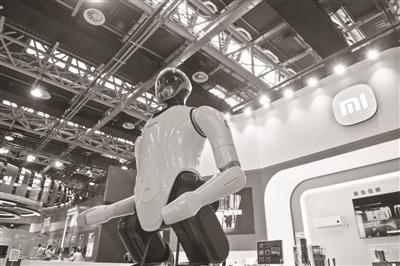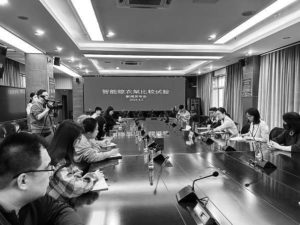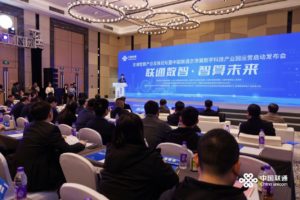AR Glasses Can Simultaneously Interpret How Smart Can Artificial Intelligence Be Now?

[ad_1]
How “smart” can artificial intelligence be now?
Flexible logistics four-way vehicle “one vehicle runs the whole warehouse” AR glasses can “simultaneous interpretation”
A full-size humanoid bionic robot with a height of 1.77 meters and a weight of 52 kilograms Photo/Reporter Li Na
At the ongoing 2023 Zhongguancun Forum, “artificial intelligence” is undoubtedly the most popular keyword. Whether it is autonomous driving or smart wearables, quantum computing or 5G communications, or even carbon neutrality, many cutting-edge technologies are inseparable from the support of artificial intelligence technology. It can be said that in the next ten years, artificial intelligence will continue to change the lives of all walks of life and ordinary people. In this forum’s International Technology Trading Conference section, the Science and Technology Expo exhibition section, and artificial intelligence-related parallel forums, Beijing Youth Daily reporters noticed that major companies have brought the latest artificial intelligence technology achievements, including the visual general segmentation model SegGPT , 5G audio and video interactive applications, bilingual digital Homo sapiens, etc.
New applications of 5G communication
Visual self-service brings a new interactive experience
The latest data shows that my country’s 5G users have reached 561 million, and my country has built and opened a total of 2.312 million 5G base stations, accounting for more than 60% of the world. In the first quarter, the national average 5G download speed was 334.98Mbps, and the peak download speed was 472.92Mbps. With such a fast Internet speed, coupled with the support of artificial intelligence, what else can it be used for besides browsing social networks and daily office and study?
The “5G New Communication Intelligent Interactive Platform” exhibited by China Unicom this time applies the characteristics of 5G “large bandwidth, low latency, and universal connection”, uses 5G audio and video interaction and AI atomic capabilities, combined with AR&VR, 3D modeling , intelligent interaction and other advanced technologies have achieved audio and video interactive applications under 5G endogenous services. The platform uses multimedia, 3D modeling, real-time tracking, sensing, intelligent interaction and other technologies to realize end-to-end visualization and intelligent new communication services, and provides 5G audio and video interaction, smart virtual image and other functions for enterprises and governments.
For example, the financial industry application version platform allows users to remotely access bank counter services, enjoying the same experience and personal privacy protection as on-site processing; the energy industry application version platform restructures the application system of the well site intelligent linkage system to realize Digital management and digital preparation of well site patrol. The transportation industry version platform provides barrier-free intelligent communication services based on 5G new communication, and provides visual and interactive smart elderly services for elderly passengers.
It is worth mentioning that the platform has realized the adaptation of the platform and domestic mobile phone chips in terms of localization adaptation and independent control; , Xiaomi, OPPO, VIVO, Meizu series of domestic mobile phones.
“Sapient” is smarter
Integration with large models can “understand your words”
Sapient, simply speaking, is a virtual person. With the help of anthropomorphic appearance and artificial intelligence core, Sapient has begun to be commercialized in many industries, assisting artificial services and improving the operating efficiency of enterprises. For example, in financial, cultural tourism, media, public service, medical care, retail and other industry scenarios, digital smart people can play the role of customer service agent, financial consultant, broadcast host, and tour guide; in cultural and entertainment scenarios, they can act as virtual idols, Virtual singers form IP assets; in scenarios such as smart vehicles, smart transportation, and smart homes, they can be combined with smart devices to provide users with smart services.
Tencent Cloud’s intelligent small-sample Homo sapiens production platform was released for the first time recently. It only needs 3 minutes of live-action video and 100 sentences of voice material. The platform can input audio and text multi-modal data to model and generate high-definition portraits in real time. Within 24 hours, a “sapient” similar to a real person was produced. Compared with digital humans generated from photos that can only present facial shapes, Homo sapiens with a small sample size can design gestures based on text, lip movements, mouth shapes, and expressions to reproduce real-life styles.
At this year’s Zhongguancun Forum, a reporter from the Beijing Youth Daily also tried to use a virtual anchor of a sapiens instead of a real anchor to broadcast a 7×24 live broadcast service, which attracted the attention of many viewers.
However, in the past, Sapiens had significantly weaker thinking ability than real people. At the Zhongguancun Forum this time, the “Zhipu AI Brain Number Homo sapiens” launched by Zhipu AI is even smarter. It no longer sticks to a fixed interaction method, but has the ability to understand the intention of human instructions. Zhipu AI is transformed from the technical achievements of the Department of Computer Science, Tsinghua University. In 2022, the company jointly developed the bilingual 100 billion-level super-large-scale pre-training model GLM-130B, and led the construction of a high-precision general knowledge map, organically integrating the two It is a cognitive engine driven by two wheels of data and knowledge, and builds ChatGLM based on this 100 billion base model. Connect billions of users in the physical world through the cognitive large model, empower the metaverse digital human, become the base of the embodied robot, and endow the machine with the ability to “think” like a human. In addition, it is also a bilingual Sapien who can speak both Chinese and English.
“Unmanned driving” on the street
New Pedestrian Prediction Model Coming Soon
Now in Yizhuang and other places, Baidu’s self-driving vehicles can already be called. In the future, with the development of technology and the approval of policies, the safety officers on the vehicle will be withdrawn, and autonomous vehicles will be truly unmanned.
According to Baidu, the core of unmanned driving technology is the “Baidu Automotive Brain Apollo Platform”, which includes four modules: high-precision maps, positioning, perception, intelligent decision-making and control. The latest Apollo has evolved to introduce multiple deep learning-based models, released a low-speed pedestrian prediction model based on semantic maps, and introduced imitation learning based on semantic maps.
At this Zhongguancun Forum, Megvii released a self-developed smart pallet four-way shuttle system. As a discrete device in the flexible logistics system, Megvii’s smart pallet four-way vehicle can realize “one vehicle running the whole warehouse”. Why is it called “flexible logistics”? Megvii said that it is mainly because it has two major characteristics of discrete equipment and distributed control. User enterprises can flexibly combine and deploy flexibly as needed, just like building blocks. Secondly, flexibility is reflected in the “dynamic scalability” of the entire system. User companies can increase or decrease the number of four-way vehicles at any time according to changes in off-peak seasons and business growth to improve the system’s carrying capacity.
Smart cities are lower carbon
AI “housekeeper” manages all water, electricity and air conditioners
In the construction of smart cities, AI plays an increasingly important role. For example, AI can be used in infrastructure management of cities, such as automatically monitoring the structural health of roads, bridges and buildings, and detecting and repairing cracks and potholes in roads; AI can help cities manage energy, such as by analyzing energy use Data can be used to achieve more efficient energy use and optimize the city’s energy system; AI can also help cities protect the environment, such as improving the city’s environmental quality through air quality monitoring, waste disposal, and water resource management.
So, how to use AI to reduce carbon in buildings to achieve the goal of carbon neutral carbon peak? The carbon management platform based on the building brain neural network system exhibited by Henghua Digital, from the perspective of making full use of clean energy, concentrates on the application of cost-effective technical products, and covers the sensing and sensing nodes at the end of the building and the sensing and sensing of major energy-consuming equipment. The nodes are coordinated and managed through the edge computing server of the building brain, so that the energy-consuming equipment of the building can operate efficiently and eliminate unnecessary energy waste as much as possible. According to the analysis of the edge computing model, the energy consumption curve of each energy-using subsystem of the building is in a stable running state. The overall energy consumption is the lowest.
Among them, building power consumption should take the first place in building energy consumption. According to the characteristics of building weak current system, without increasing decoration construction, a set of weak current monitoring and AI control system with smaller volume, accurate measurement and convenient installation has been developed. , It can dynamically monitor the power system of the building to ensure timely power outage in uninhabited areas and avoid unnecessary waste of power. The energy consumption of building air-conditioning systems accounts for 40% of the total energy consumption of buildings. Henghua Digital developed a strategic algorithm for the optimization of building cooling and heat source systems through in-depth cooperation with universities and established industry-university-research bases, forming a mature data algorithm model , making the energy saving rate of the air conditioning system reach more than 10%. At present, this project has been implemented in Guangdong, Tianjin, Jiangxi, Sichuan, Hubei, Anhui and other provinces. In the future, residential quarters, office buildings, shopping malls, etc. will all “evolve” in a green and low-carbon direction.
AR glasses “simultaneous interpretation”
Smart Wearable Devices Facilitate Accessibility
As artificial intelligence is integrated into all aspects of life, devices equipped with artificial intelligence tend to be miniaturized. For example, smart watches can answer calls, reply to WeChat, monitor sports conditions, etc.; smart glasses look like ordinary glasses, and can answer calls, Listen to music etc.
However, the smart glasses displayed at the Zhongguancun Forum are more practical. The name “Liangliang Listener Smart Glasses” is a binocular waveguide AR smart glasses.
After wearing VR glasses, you will be immersed in the virtual world, while AR glasses will not block the line of sight. It will integrate the real world with the virtual world, so as to realize some functions that cannot be done in the real world. For example, hearing-impaired people often encounter difficulties in work, social interaction, and learning due to “inaudible” or “inaudible” sounds. This glasses can convert sound information into text and display it in front of your eyes. It also has the function of simultaneous interpretation, which can recognize the languages of different countries and convert them into Chinese characters or texts of other countries before being presented, helping users to understand in an international language communication environment. The glasses are light and portable, and the body weighs only 79g. Compared with the 200-300g AR glasses currently on the market, its weight is very suitable for long-term wearing; it can also be adapted to lenses for myopia, hyperopia, astigmatism, presbyopia, etc.; glasses There is no light leakage on the outside, protecting privacy, and the content can only be seen by yourself; this glasses is also equipped with millisecond-level real-time subtitles, noise reduction algorithms, accurate audio recording within 5 meters, and a translation accuracy rate of up to 95%. It is reported that this product is already capable of mass production.
Privacy Preserving Computing Technology Open Source
Applied in finance, medical insurance and other fields
Privacy computing, also known as privacy protection computing, refers to a series of information technologies that analyze and calculate data on the premise that the data provider does not disclose the original data, and realize “available and invisible” in the process of data circulation and fusion. So as to realize the transformation and release of data value. Privacy-preserving computing provides the protection capabilities that future industries urgently need for private data. At this Zhongguancun Forum Exhibition (Tech Expo), Ant Group announced for the first time the complete open source layout with key basic software as the core. All nine core technologies are open source, including the privacy computing technology “crypto”. In other words, this technology platform is open to users around the world. It can directly use product functions without calling and developing codes, helping users explore private computing application scenarios at low cost.
According to reports, lingo has been applied in financial, medical, insurance and other scenarios. For example, Shanghai Pudong Development Bank and Ant Group’s Lingyu platform identified more than 145,000 high-risk users and prevented the issuance of billions of yuan in high-risk loans. In terms of medical care, the Ant Privacy Computing Platform and Alibaba Cloud’s digital medical team have cooperated to build a data fusion platform for hospital operations and management, provide managers with digital performance management analysis, help hospitals establish a refined operation management system, and reduce hospitals. Economic risk or clinical risk. In addition, in the past, in the process of claim settlement, insurance institutions will obtain unnecessary raw data by querying the medical institutions of the insured’s diagnosis and treatment status in plain text (that is, the data is not encrypted). Ant’s solution, by setting data logic query and using privacy computing technologies such as multi-party secure computing, allows insurance companies to only obtain the query results of whether claims are settled, and will not obtain various raw data, protecting the privacy of claim settlement users.
sound
Large-scale models will change the world while developing control technology
ChatGPT is one of the most interesting new things in the technology world in 2023. Its release has also triggered a frenzy of large-scale language models. Many companies such as Baidu, Ali, Zhihu, SenseTime, and JD.com have launched their large-scale models. Another major field of AI – visual GPT also appeared at this Zhongguancun Forum: the vision team of Zhiyuan Research Institute officially launched the general segmentation model SegGPT, which is the first general vision model that uses visual cues to complete arbitrary segmentation tasks.
According to reports, when SegGPT is used, it abandons the traditional thinking of language-based large models, and uses images instead of text when interacting with machines. For example, the user gives SegGPT a picture and circles the “rainbow” on it. When the user gives many pictures containing rainbows, SegGPT can automatically recognize the rainbow above and circle these parts. It can be said that SegGPT is “one-size-fits-all”: given one or several sample images and intent masks, the model can get the user’s intent and “learn like a sample” to complete similar segmentation tasks. In addition, SegGPT is also “one-touch”: through a point or bounding box, an interactive prompt is given on the picture to be predicted to identify the specified object on the split screen. Using this feature, many functions can be realized. For example, when the robot manipulator picks up tomatoes and other objects, the robot can quickly know where the edge of the tomato is. It can pick up the tomato without crushing it, which is very accurate.
At present, domestic large-scale models are in a state where a hundred flowers are blooming and a hundred schools of thought are contending. Robin Li, founder, chairman and CEO of Baidu, said at the Zhongguancun Forum that artificial intelligence has once again become the focus of human innovation, and more and more people recognize that the fourth industrial revolution is coming. He emphasized: “Big models have changed artificial intelligence, and big models are about to change the world.” Dai Qionghai, academician of the Chinese Academy of Engineering and chairman of the Chinese Association for Artificial Intelligence, also said that artificial intelligence will bring about changes in many aspects of application: oriented to the new paradigm of scientific research ( The origin of the universe, the laws of nature, the mysteries of life); for people’s life and health (AI drug research and development, remote virtual surgery); for the main economic battlefield (virtual creation, industrial manufacturing, spiritual interaction); for major national defense needs (multi-source situation analysis, AI ground-air front deployment) and so on.
It is worth noting that in the face of new changes, some people have raised warnings. Kai-fu Lee, chairman and CEO of Sinovation Ventures, said, “AI will still make mistakes and talk nonsense in a serious manner. It can only be used to generate the first draft of content and develop ideas, not the final version. AI needs continuous manual intervention to avoid Fallacies or disasters occur. In addition, AI may still have some legal and ethical issues. Therefore, AI is not suitable for all fields and can only be applied to applications with a high degree of fault tolerance.” Kai-Fu Lee emphasized, “AI may create false information and may It is used by criminals to deceive users in a targeted manner. Therefore, when developing, it is necessary to study the laws and regulations that control AI technology and management at the same time.”
[ad_2]
Source link








